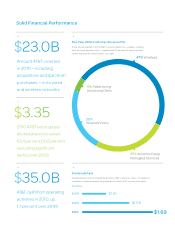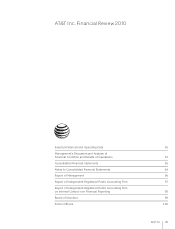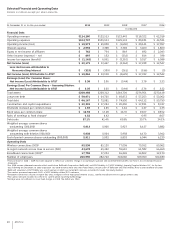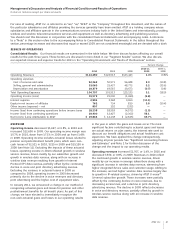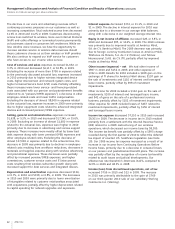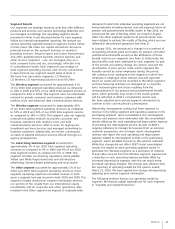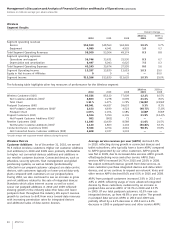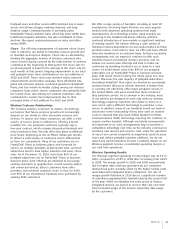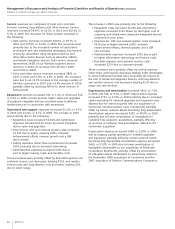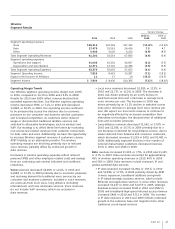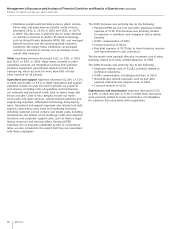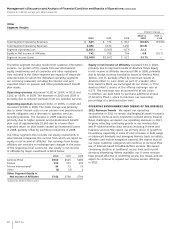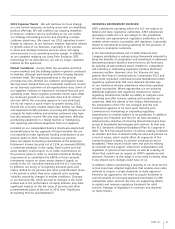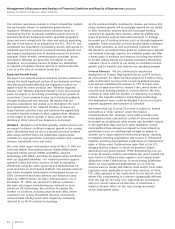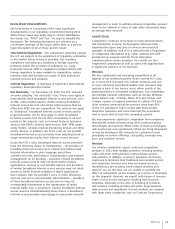AT&T Wireless 2010 Annual Report Download - page 35
Download and view the complete annual report
Please find page 35 of the 2010 AT&T Wireless annual report below. You can navigate through the pages in the report by either clicking on the pages listed below, or by using the keyword search tool below to find specific information within the annual report.
AT&T Inc. 33
decisions for which the individual operating segments are not
being evaluated, including interest cost and expected return on
pension and postretirement benefits assets. In May 2010, we
announced the sale of Sterling, which we closed in August
2010. The Other segment results for all periods shown have
been restated to exclude the results of Sterling, which are now
reflected in discontinued operations (see Note 2).
In January 2011, we announced a change in our method of
recognizing actuarial gains and losses for pension and other
postretirement benefits as well as the attribution of those
benefit costs to our segments (see Note 1). Historically, the
total benefit costs were attributed to each segment. As part
of the benefit accounting change, the service cost and the
amortization of prior service costs, which represent the
benefits earned by active employees during the period,
will continue to be attributed to the segment in which the
employee is employed, while interest cost and expected
return on assets will now be recorded in the Other segment
as those financing activities are managed on a corporate
level. Actuarial gains and losses resulting from the
remeasurement of our pension and postretirement benefit
plans, which generally only occurs in the fourth quarter,
will be reflected in AT&T’s consolidated results only.
We have adjusted prior-period segment information to
conform to the current period’s presentation.
Historically, intersegment activity had been reported as
revenue in the billing segment and operating expense in the
purchasing segment. Upon consolidation, the intersegment
revenue and expense were eliminated with the consolidated
results reflecting the cash operating and depreciation expense
of providing the intersegment service. As part of AT&T’s
ongoing initiatives to manage its business from an external
customer perspective, we no longer report intersegment
revenue and report the cash operating and depreciation
expense related to intersegment activity in the purchasing
segment, which provided services to the external customer.
While this change did not affect AT&T’s total consolidated
results, the impact to each operating segment varied. In
particular, the Wireless segment, as a purchaser of network,
IT and other services from the Wireline segment, experienced
a reduction in cash operating expense partially offset by
increased depreciation expense, with the net result being
increased operating margins. This change was effective with
the reporting of operating results for the quarter ended
March 31, 2010. We have applied this change retrospectively,
adjusting prior-period segment information.
The following sections discuss our operating results by
segment. We discuss capital expenditures for each segment
in “Liquidity and Capital Resources.”
Segment Results
Our segments are strategic business units that offer different
products and services over various technology platforms and
are managed accordingly. Our operating segment results
presented in Note 4 and discussed below for each segment
follow our internal management reporting. We analyze our
various operating segments based on segment income before
income taxes. We make our capital allocations decisions
primarily based on the network (wireless or wireline)
providing services. Actuarial gains and losses from pension
and other postretirement benefits, interest expense and
other income (expense) – net, are managed only on a
total company basis and are, accordingly, reflected only
in consolidated results. Each segment’s percentage of
total segment operating revenue and income calculations
is derived from our segment results table in Note 4.
We have four reportable segments: (1) Wireless,
(2) Wireline, (3) Advertising Solutions and (4) Other.
The Wireless segment accounted for approximately 47%
of our 2010 total segment operating revenues as compared
to 44% in 2009 and 67% of our 2010 total segment income as
compared to 63% in 2009. This segment uses our nationwide
network to provide consumer and business customers with
wireless voice and advanced data communications services.
The Wireline segment accounted for approximately 49%
of our 2010 total segment operating revenues as compared
to 52% in 2009 and 34% of our 2010 total segment income
as compared to 38% in 2009. This segment uses our regional,
national and global network to provide consumer and
business customers with landline voice and data
communications services, AT&T U-verse TV, high-speed
broadband and voice services and managed networking to
business customers. Additionally, we receive commissions
on sales of satellite television services offered through our
agency arrangements.
The Advertising Solutions segment accounted for
approximately 3% of our 2010 total segment operating
revenues as compared to 4% in 2009 and 4% of our 2010
total segment income as compared to 6% in 2009. This
segment includes our directory operations, which publish
Yellow and White Pages directories and sell directory
advertising, Internet-based advertising and local search.
The Other segment accounted for approximately 1% of our
2010 and 2009 total segment operating revenues. Since
segment operating expenses exceeded revenue in both
years, a segment loss was incurred in both 2010 and 2009. This
segment includes results from customer information services,
our portion of the results from our international equity
investments and all corporate and other operations. Also
included in the Other segment are impacts of corporate-wide




